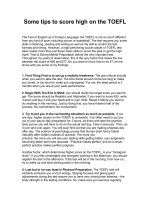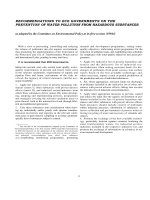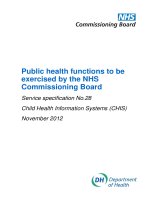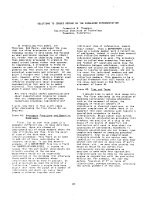H OW TO BE HAVE ON THE WARDS pptx
Bạn đang xem bản rút gọn của tài liệu. Xem và tải ngay bản đầy đủ của tài liệu tại đây (962.52 KB, 21 trang )
HOW TO BEHAVE ON THE WARDS
Be on Time
Most OB/GYN teams begin rounding between 6 and 7
A.M. If you are expected
to “pre-round,” you should give yourself at least 10 minutes per patient that
you are following to see the patient and learn about the events that occurred
overnight. Like all working professionals, you will face occasional obstacles to
punctuality, but make sure this is occasional. When you first start a rotation,
try to show up at least 15 minutes early until you get the routine figured out.
Dress in a Professional Manner
Even if the resident wears scrubs and the attending wears stiletto heels, you
must dress in a professional, conservative manner. Wear a short white coat
over your clothes unless discouraged (as in pediatrics).
Men should wear long pants, with cuffs covering the ankle, a long col-
lared shirt, and a tie. No jeans, no sneakers, no short-sleeved shirts.
Women should wear long pants or knee-length skirt, blouse or dressy
sweater. No jeans, no sneakers, no heels greater than 1
1
⁄
2 inches, no open-
toed shoes.
Both men and women may wear scrubs occasionally, during overnight
call or in the operating room or birthing ward. Do not make this your uni-
form.
Act in a Pleasant Manner
The rotation is often difficult, stressful, and tiring. Smooth out your experi-
ence by being nice to be around. Smile a lot and learn everyone’s name. If you
do not understand or disagree with a treatment plan or diagnosis, do not
“challenge.” Instead, say “I’m sorry, I don’t quite understand, could you please
explain . . .”
Try to look interested to attendings and residents. Sometimes this stuff is bor-
ing, or sometimes you’re not in the mood, but when someone is trying to
teach you something, look grateful and not tortured.
Always treat patients professionally and with respect. This is crucial to prac-
ticing good medicine, but on a less important level if a resident or attending
spots you being impolite or unprofessional, it will damage your grade and eval-
uation quicker than any dumb answer on rounds ever could. And be nice to
the nurses. Really nice. Learn names; bring back pens and food from pharma-
ceutical lunches and give them out. If they like you, they can make your life a
lot easier and make you look good in front of the residents and attendings.
Be Aware of the Hierarchy
The way in which this will affect you will vary from hospital to hospital and
team to team, but it is always present to some degree. In general, address your
questions regarding ward functioning to interns or residents. Address your
medical questions to attendings; make an effort to be somewhat informed on
2
INTRODUCTION
your subject prior to asking attendings medical questions. But please don’t ask
a question just to transparently show off what you know. It’s annoying to
everyone. Show off by seeming interested and asking real questions that you
have when they come up.
Address Patients and Staff in a Respectful Way
Address patients as Sir or Ma’am, or Mr., Mrs., or Miss. Try not to address pa-
tients as “honey,” “sweetie,” and the like. Although you may feel these names
are friendly, patients will think you have forgotten their name, that you are
being inappropriately familiar, or both. Address all physicians as “doctor,” un-
less told otherwise.
Be Helpful to Your Residents
That involves taking responsibility for patients that you’ve been assigned to,
and even for some that you haven’t. If you’ve been assigned to a patient, know
everything there is to know about her, her history, test results, details about
her medical problems, and prognosis. Keep your interns or residents informed
of new developments that they might not be aware of, and ask them for any
updates as well.
If you have the opportunity to make a resident look good, take it. If some new
complication comes up with a patient, tell the resident about it before the at-
tending gets a chance to grill the resident on it. And don’t hesitate to give
credit to a resident for some great teaching in front of an attending. These
things make the resident’s life easier, and he or she will be grateful and the re-
wards will come your way.
Volunteer to do things that will help out. So what if you have to run to the
lab to follow up on a stat H&H. It helps everybody out, and it is appreciated.
Observe and anticipate. If a resident is always hunting around for some tape
to do a dressing change every time you round on a particular patient, get some
tape ahead of time.
Respect Patients’ Rights
1. All patients have the right to have their personal medical information
kept private. This means do not discuss the patient’s information with
family members without that patient’s consent and do not discuss any
patient in hallways, elevators, or cafeterias.
2. All patients have the right to refuse treatment. This means they can
refuse treatment by a specific individual (you, the medical student) or
of a specific type (no nasogastric tube). Patients can even refuse life-
saving treatment. The only exceptions to this rule are a patient who is
deemed to not have the capacity to make decisions or understand situ-
ations—in which case a health care proxy should be sought—or a pa-
tient who is suicidal or homicidal.
3. All patients should be informed of the right to seek advanced direc-
tives on admission. This is often done by the admissions staff, in a
booklet. If your patient is chronically ill or has a life-threatening ill-
ness, address the subject of advanced directives with the assistance of
your attending.
3
INTRODUCTION
More Volunteering
Be self-propelled, self-motivated. Volunteer to help with a procedure or a diffi-
cult task. Volunteer to give a 20-minute talk on a topic of your choice. Volun-
teer to take additional patients. Volunteer to stay late. The more unpleasant
the task, the better.
Be a Team Player
Help other medical students with their tasks; teach them information you
have learned. Support your supervising intern or resident whenever possible.
Never steal the spotlight, steal a procedure, or make a fellow medical student
look bad.
Be Honest
If you don’t understand, don’t know or didn’t do it, make sure you always say
that. Never say or document information that is false (for example, don’t say
“bowel sounds normal” when you did not listen).
Keep Patient Information Handy
Use a clipboard, notebook, or index cards to keep patient information, includ-
ing a miniature history and physical, lab, and test results at hand.
Present Patient Information in an Organized Manner
Here is a template for the “bullet” presentation:
“This is a [age]-year-old [gender] with a history of [major history such as
abdominal surgery, pertinent OB/GYN history] who presented on [date]
with [major symptoms, such as pelvic pain, fever], and was found to have
[working diagnosis]. [Tests done] showed [results]. Yesterday the patient
[state important changes, new plan, new tests, new medications]. This
morning the patient feels [state the patient’s words], and the physical exam
is significant for [state major findings]. Plan is [state plan].
The newly admitted patient generally deserves a longer presentation following
the complete history and physical format (see below).
Some patients have extensive histories. The whole history can and probably
should be present in the admission note, but in ward presentation it is often
too much to absorb. In these cases, it will be very much appreciated by your
team if you can generate a good summary that maintains an accurate picture
of the patient. This usually takes some thought, but it’s worth it.
Document Information in an Organized Manner
A complete medical student initial history and physical is neat, legible, orga-
nized, and usually two to three pages long (see Figure 1-1).
4
INTRODUCTION
HOW TO ORGANIZE YOUR LEARNING
The main advantage to doing the OB/GYN clerkship is that you get to see pa-
tients. The patient is the key to learning, and the source of most satisfaction
and frustration on the wards. One enormously helpful tip is to try to skim this
book before starting your rotation. Starting OB/GYN can make you feel like
you’re in a foreign land, and all that studying the first two years doesn’t help
much. You have to start from scratch in some ways, and it will help enor-
mously if you can skim through this book before you start. Get some of the
terminology straight, get some of the major points down, and it won’t seem so
strange.
Select Your Study Material
We recommend:
Ⅲ This review book, First Aid for the Clinical Clerkship in Obstetrics & Gy-
necology
Ⅲ A full-text online journal database, such as www.mdconsult.com (sub-
scription is $99/year for students)
Ⅲ A small pocket reference book to look up lab values, clinical pathways,
and the like, such as Maxwell Quick Medical Reference (ISBN
0964519119, $7)
Ⅲ A small book to look up drugs, such as Pocket Pharmacopoeia (Tarascon
Publishers, $8)
As You See Patients, Note Their Major Symptoms
and Diagnosis for Review
Your reading on the symptom-based topics above should be done with a spe-
cific patient in mind. For example, if a postmenopausal patient comes to the
office with increasing abdominal girth and is thought to have ovarian cancer,
read about ovarian cancer in the review book that night.
Prepare a Talk on a Topic
You may be asked to give a small talk once or twice during your rotation. If
not, you should volunteer! Feel free to choose a topic that is on your list; how-
ever, realize that this may be considered dull by the people who hear the lec-
ture. The ideal topic is slightly uncommon but not rare. To prepare a talk on a
topic, read about it in a major textbook and a review article not more than
two years old, and then search online or in the library for recent develop-
ments or changes in treatment.
5
INTRODUCTION
HOW TO PREPARE FOR THE CLINICAL CLERKSHIP EXAM
If you have read about your core illnesses and core symptoms, you will know a
great deal about medicine. To study for the clerkship exam, we recommend:
2 to 3 weeks before exam: Read the entire review book, taking notes.
10 days before exam: Read the notes you took during the rotation on
your core content list and the corresponding review book sections.
5 days before exam: Read the entire review book, concentrating on lists
and mnemonics.
2 days before exam: Exercise, eat well, skim the book, and go to bed
early.
1 day before exam: Exercise, eat well, review your notes and the
mnemonics, and go to bed on time. Do not have any caffeine after 2
P.M.
Other helpful studying strategies include:
Study with Friends
Group studying can be very helpful. Other people may point out areas that
you have not studied enough and may help you focus on the goal. If you tend
to get distracted by other people in the room, limit this to less than half of
your study time.
Study in a Bright Room
Find the room in your house or in your library that has the best, brightest
light. This will help prevent you from falling asleep. If you don’t have a bright
light, get a halogen desk lamp or a light that simulates sunlight (not a tanning
lamp).
Eat Light, Balanced Meals
Make sure your meals are balanced, with lean protein, fruits and vegetables,
and fiber. A high-sugar, high-carbohydrate meal will give you an initial burst
of energy for 1 to 2 hours, but then you’ll drop.
Take Practice Exams
The point of practice exams is not so much the content that is contained in
the questions but the training of sitting still for 3 hours and trying to pick the
best answer for each and every question.
Tips for Answering Questions
All questions are intended to have one best answer. When answering ques-
tions, follow these guidelines:
Read the answers first. For all questions longer than two sentences, read-
ing the answers first can help you sift through the question for the key in-
formation.
Look for the words “EXCEPT,” “MOST,” “LEAST,” “NOT,”
“BEST,” “WORST,” “TRUE,” “FALSE,” “CORRECT,” “INCOR-
6
INTRODUCTION
RECT,” “ALWAYS,” and “NEVER.” If you find one of these words, cir-
cle or underline it for later comparison with the answer.
Evaluate each answer as being either true or false. Example:
Which of the following is least likely to be associated with pelvic pain?
A. endometriosis T
B. ectopic pregnancy T
C. ovarian cancer ? F
D. ovarian torsion T
By comparing the question, noting LEAST, to the answers, “C” is the best an-
swer.
SAMPLE PROGRESS NOTES AND ORDERS
Terminology
G (gravidity) 3 = total number of pregnancies, including normal and ab-
normal intrauterine pregnancies, abortions, ectopic pregnancies, and hy-
datidiform moles (Remember, if patient was pregnant with twins, G = 1.)
P (parity) 3 = number of deliveries > 500 grams or ≥ 24 weeks’ gestation,
stillborn (dead) or alive (Remember, if patient was pregnant with twins,
P = 1.)
Ab (abortion) 0 = number of pregnancies that terminate < 24th gesta-
tional week or in which the fetus weighs < 500 grams
LC (living children) 3 = number of successful pregnancy outcomes (Re-
member, if patient was pregnant with twins, LC = 2.)
Or use the “TPAL” system if it is used at your medical school:
T = number of term deliveries (3)
P = number of preterm deliveries (0)
A = number of abortions (0)
L = number of living children (3)
SAMPLE OBSTETRIC ADMISSION HISTORY AND PHYSICAL
Date
Time
Identification: 25 yo G3P2
Estimated gestational age (EGA): 38 5/7 weeks
Last menstrual period (LMP): First day of LMP
Estimated date of confinement: Due date (specify how it was determined)
by LMP or by ____ wk US (Sonograms are most accurate for dating EGA
when done at < 20 weeks.)
Chief complaint (CC): Uterine contractions (UCs) q 7 min since 0100
History of present illness (HPI): 25 yo G3P2 with an intrauterine preg-
nancy (IUP) at 38 5/7 wks GA, well dated by LMP (10/13/99) and US at
10 weeks GA, who presented to L&D with CC of uterine contractions q 7
min. Prenatal care (PNC) at Highland Hospital (12 visits, first visit at 7
wks GA), uterine size = to dates, prenatal BP range 100–126/64–83. Prob-
lem list includes H/o + group B Streptococcus (GBS) and a +PPD with sub-
sequent negative chest x-ray in 5/00. Pt admitted in early active labor
with a vaginal exam (VE) 4/90/−2.
7
INTRODUCTION
Past Obstetric History
’92 NSVD @ term, wt 3,700 g, no complications
’94 NSVD @ term, wt 3,900 g, postpartum hemorrhage
Allergies: NKDA
Medications: PNV, Fe
Medical Hx: H/o asthma (asymptomatic × 7 yrs), UTI × 1 @ 30 wks s/p
Macrobid 100 mg × 7 d, neg PPD with subsequent neg CXR (5/00)
Surgical Hx: Negative
Social Hx: Negative
Family Hx: Mother—DM II, father—HTN
ROS: Bilateral low back pain
PE
General appearance: Alert and oriented (A&O), no acute distress
(NAD)
Vital signs: T, BP, P, R
HEENT: No scleral icterus, pale conjunctiva
Neck: Thyroid midline, no masses, no lymphadenopathy (LAD)
Lungs: CTA bilaterally
Back: No CVA tenderness
Heart: II/VI SEM
Breasts: No masses, symmetric
Abdomen: Gravid, nontender
Fundal height: 36 cm
Estimated fetal weight (EFW): 3,500 g by Leopold’s
Presentation: Vertex
Extremities: Mild lower extremity edema, nonpitting
Pelvis: Adequate
VE: Dilatation (4 cm)/effacement (90%)/station (−2); sterile speculum
exam (SSE)? (Nitrazine?, Ferning?, Pooling?); membranes intact
US (L&D): Vertex presentation confirmed, anterior placenta, AFI = 13.2
Fetal monitor: Baseline FHR = 150, reactive. Toco = UCs q 5 min
Labs
Blood type: A+
Antibody screen: Neg
Rubella: Immune
HbsAg
VDRL: Nonreactive
FTA
GC
Chlamydia
HIV: See prenatal records
1 hr GTT: 105
3 hr GTT
PPD: + s/p neg CXR
CXR: Neg 5/00
AFP: Neg x 3
Amnio
PAP: NL
Hgb/Hct
Urine: + blood, − protein, − glucose, − nitrite, 2 WBCs
GBS: +
8
INTRODUCTION
Assessment
1. Intrauterine pregancy @ 38 5/7 wks GA in early active labor
2. Group B strep +
3. H/o + PPD with subsequent − CXR 5/00
4. H/o UTI @ 30 wks GA, s/p Rx—resolved
5. H/o asthma—stable × 7 yrs, no meds
Plan
1. Admit to L&D
2. NPO except ice chips
3. H&H, VDRL, and hold tube
4. D5 LR TRA 125 cc/hr
5. Ampicillin 2 g IV load, then 1 g IV q 4 hrs (for GBS)
6. External fetal monitors (EFMs)
7. Prep and enema
SAMPLE DELIVERY NOTE
Always sign and date your notes.
NSVD of viable male infant over an intact perineum @ 12:35
P.M., Apgars
8&9, wt 3,654 g without difficulty. Position LOA, bulb suction, nuchal cord ×
1 reducible. Spontaneous delivery of intact 3-vessel cord placenta @ 12:47
P
.M., fundal massage and pitocin initiated, fundus firm. 2nd-degree perineal
laceration repaired under local anesthesia with 3-0 vicryl. Estimated blood
loss (EBL) = 450 cc. Mom and baby stable. Doctors: Johnson & Feig.
SAMPLE POSTPARTUM NOTE
S: Pt ambulating, voiding, tolerating a regular diet
O: Vitals
Heart: RR without murmurs
Lungs: CTA bilaterally
Breasts: Nonengorged, colostrum expressed bilaterally
Fundus: Firm, mildly tender to palpation, 1 fingerbreadth below umbilicus
Lochia: Moderate amount, rubra
Perineum: Intact, no edema
Extremities: No edema, nontender
Postpartum Hgb: 9.7
VDRL: NR
A: S/p NSVD, PP day # 1—progressing well, afebrile, stable
P: Continue postpartum care
9
INTRODUCTION
SAMPLE POST-NSVD DISCHARGE ORDERS
1. D/c pt home
2. Pelvic rest × 6 weeks
3. Postpartum check in 4 weeks
4. D/c meds: FeSO
4
300 mg 1 tab PO tid, #90 (For Hgb < 10; opinions
vary on when to give FE postpartum)
Colace 100 mg 1 tab PO bid PRN no bowel movement, #60
SAMPLE POST–CESAREAN SECTION NOTE
S: Pt c/o abdominal pain, no flatus, minimal ambulation
O: Vitals
I&O (urinary intake and output): Last 8 hrs = 750/695
Heart: RR without murmurs
Lungs: CTA bilaterally
Breasts: Nonengorged, no colostrum expressed
Fundus: Firm, tender to palpation, 1 fingerbreadth above umbilicus; in-
cision without erythema/edema; C/D/I (clean/dry/intact); nor-
mal abdominal bowel sounds (NABS)
Lochia: Scant, rubra
Perineum: Intact, Foley catheter in place
Extremities: 1+ pitting edema bilateral LEs, nontender
Postpartum Hgb: 11
VDRL: NR
A: S/p primary low-transverse c/s secondary to arrest of descent, POD # 1−
afebrile, + flatus, stable
P: 1. D/c Foley
2. Strict I&O––Call HO if UO < 120 cc/4 hrs
3. Clear liquid diet
4. Heplock IV once patient tolerates clears
5. Ambulate qid
6. Incentive spirometry 10×/hr
7. Tylenol #3 2 tabs PO q 4 hrs PRN pain
SAMPLE DISCHARGE ORDERS POST–CESAREAN SECTION
1. D/c patient home
2. Pelvic rest × 4 weeks
3. Incision check in 1 week
4. Discharge meds:
Tylenol #3 1–2 tabs PO q 4 hrs PRN pain, #30
Colace 100 mg 1 tab PO bid, #60
10
INTRODUCTION
11
SECTION IIA
High-Yield Facts
in Obstetrics
Normal Anatomy
Diagnosis of Pregnancy
Physiology of Pregnancy
Antepartum
Intrapartum
Postpartum
Medical Conditions and
Infections in Pregnancy
Complications of
Pregnancy
Spontaneous Abortion,
Ectopic Pregnancy, and
Fetal Death
Induced Abortion
12
NOTES
VULVA
The vulva consists of the labia majora, labia minora, mons pubis, clitoris,
vestibule of the vagina, vestibular bulb, and the greater vestibular glands. Ba-
sically, it is the external female genitalia (see Figure 2-1).
Blood Supply
From branches of the external and internal pudendal arteries
HIGH-YIELD FACTS IN
Normal Anatomy
FIGURE 2-1. External female genitalia.
(Reproduced, with permission, from Pernoll ML. Handbook of Obstetrics and Gynecology, 10th ed. New York: McGraw-Hill,
2001: 22.)
13
Lymph
Medial group of superficial inguinal nodes
Nerve Supply
Anterior parts of vulva: Ilioinguinal nerves and the genital branch of the
genitofemoral nerves
Posterior parts: Perineal nerves and posterior cutaneous nerves of the thigh
VAGINA
Blood Supply
Ⅲ Vaginal branch of the uterine artery is the primary supply of the
vagina.
Ⅲ Middle rectal and inferior vaginal branches of the hypogastric artery
(internal iliac artery) are secondary blood supplies.
Nerve Supply
Ⅲ Hypogastric plexus—sympathetic innervation
Ⅲ Pelvic nerve—parasympathetic innervation
UTERUS
Components of the Uterus
Ⅲ Fundus: Uppermost region of uterus
Ⅲ Corpus: Body of the uterus
Ⅲ Cornu: Part of uterus that joins the fallopian tubes
Ⅲ Cervix: Inferior part of cervix that connects to the vagina via the cervi-
cal canal
Ⅲ Internal os: Opening of cervix on the uterine side
Ⅲ External os: Opening of cervix on the vaginal side
Histology
Mesometrium: The visceral layer of the peritoneum reflects against the
uterus and forms this outmost layer of the organ (the side that faces the
viscera).
Myometrium: The smooth muscle layer of uterus. It has three parts:
1. Outer longitudinal
2. Middle oblique
3. Inner longitudinal
Endometrium: The mucosal layer of the uterus, made up of columnar ep-
ithelium
14
HIGH-YIELD FACTS
Normal Anatomy
Blood Supply
Uterine arteries—arise from internal iliac artery
Ovarian arteries
Nerve Supply
Ⅲ Superior hypogastric plexus
Ⅲ Inferior hypogastric plexus
Ⅲ Common iliac nerves
LIGAMENTS OF THE PELVIC VISCERA
Broad ligament: Extends from the lateral pelvic wall to the uterus and ad-
nexa. Contains the fallopian (uterine) tube, round ligament, uterine and
ovarian blood vessels, lymph, utererovaginal nerves, and ureter (see Figure
2-2).
Round ligament: The remains of the gubernaculum; extends from the
corpus of the uterus down and laterally through the inguinal canal and
terminates in the labia majora.
Cardinal ligament: Extends from the cervix and lateral vagina to the
pelvic wall; functions to support the uterus.
FALLOPIAN (UTERINE) TUBES
The fallopian tubes extend from the superior lateral aspects of the uterus
through the superior fold of the broad ligament laterally to the ovaries.
15
HIGH-YIELD FACTS
Normal Anatomy
FIGURE 2-2. Supporting structures of the pelvic viscera.
(Reproduced, with permission, from Lindarkis NM, Lott S. Digging Up the Bones: Obstetrics and Gynecology. New York:
McGraw-Hill, 1998: 2.)
Parts, from Lateral to Medial
Ⅲ Infundibulum: The lateralmost part the uterine tube. The free edge is
connected to the fimbriae.
Ⅲ Ampulla: Widest section
Ⅲ Isthmus: Narrowest part
Ⅲ Intramural part: Pierces uterine wall
Blood Supply
From uterine and ovarian arteries
Nerve Supply
Pelvic plexus (autonomic) and ovarian plexus
OVARIES
The ovaries lie on the posterior aspect of the broad ligament, and are attached
to the broad ligament by the mesovarium. They are not covered by peri-
toneum.
Blood Supply
Ovarian artery, which arises from the aorta at the level of L1. Veins drain into
the vena cava on the right side and the left renal vein on the left.
Nerve Supply
Derived from the aortic plexus
16
HIGH-YIELD FACTS
Normal Anatomy
FIGURE 2-3. Fascia of the pelvis.
(Reproduced, with permission, from Lindarkis NM, Lott S. Digging Up the Bones: Obstetris and Gynecology. New York:
McGraw-Hill, 1998: 2.)
Histology
Ovaries are covered by tunica albuginea, a fibrous capsule. The tunica albu-
ginea is covered by germinal epithelium.
17
HIGH-YIELD FACTS
Normal Anatomy
18
HIGH-YIELD FACTS
Normal Anatomy
NOTES
19
History
The majority of women have amenorrhea from the last menstrual period
(LMP) until after the birth of their baby.
Symptoms
Although not specific to pregnancy, these symptoms may alert the patient to
the fact that she is pregnant:
Ⅲ Breast enlargement and tenderness from about 6 weeks’ gestational age
(GA)
Ⅲ Areolar enlargement and increased pigmentation after 6 weeks’ GA
Ⅲ Colostrum secretion may begin after 16 weeks’ GA
Ⅲ Nausea with or without vomiting, from about the date of the missed pe-
riod
Ⅲ Urinary frequency, nocturia, and bladder irritability due to increased
bladder circulation and pressure from the enlarging uterus
Signs
Some clinical signs can be noted, but may be difficult to quantify:
Ⅲ Breast enlargement, tension, and venous distention—particularly obvi-
ous in the primigravida
Ⅲ Bimanual examination reveals a soft, cystic, globular uterus with en-
largement consistent with the duration of pregnancy (see Table 3-1)
Ⅲ Chadwick’s sign: Bluish discoloration of vagina and cervix, due to con-
gestion of pelvic vasculature
PREGNANCY TESTING
How?
The beta subunit of human chorionic gonadotropin (hCG) is detected in ma-
ternal serum or urine.
Ⅲ hCG is a glycoprotein produced by the developing placenta shortly af-
ter implantation
HIGH-YIELD FACTS IN
Diagnosis of Pregnancy
Some women experience
vaginal bleeding in
pregnancy, and therefore
fail to recognize their
condition.
Nausea and/or vomiting
occurs in approximately
50% of pregnancies, most
notably at 2 to 12 weeks’
GA, and typically in the
A.M.
hCG is a glycoprotein
hormone composed of
alpha and beta subunits.
Hyperemesis gravidarium-
persistent vomiting that
results in weight loss,
dehydration, acidosis from
starvation, alkylosis from
loss of HCl in vomitus, and
hypokalemia.
Ⅲ A monoclonal antibody to the hCG antigen is utilized → the hCG–
antibody complex is measured qualitatively
Pregnancy tests not only detect hCG produced by the syncytiotrophoblast
cells in the placenta, but also in:
Ⅲ Hydatidiform mole
Ⅲ Choriocarcioma
Ⅲ Other germ cell tumors
Ⅲ Ectopically producing breast cancers and large cell carcinoma of the
lung
When?
Ⅲ Blood levels become detectably elevated 8 to 10 days after fertilization
(3 to 3.5 weeks after the LMP)
Ⅲ hCG rises in a geometric fashion during T1, producing different ranges
for each week of gestation:
Duration of Pregnancy Plasma hCG
(from Time of Ovulation) (mU/mL)
1 week 5–50
2 weeks 50–500
3 100–10,000
4 1,000–30,000
5 3,500–115,000
6–8 12,000–270,000
8–12 15,000–220,000
20–40 3,000–15,000
Urine hCG
Ⅲ Preferred method to recognize normal pregnancy
Ⅲ Total urine hCG closely parallels plasma concentration
Ⅲ First morning specimens have less variability in relative concentration
and generally higher levels, improving accuracy
Ⅲ Assays detecting 25 mU/mL recognize pregnancy with 95% sensitivity
by 1 week after the first missed menstrual period
20
HIGH-YIELD FACTS
Diagnosis of Pregnancy
hCG is similar in structure
and function to luteinizing
hormone (the beta subunits
are similar in both
hormones).
The hCG alpha subunit
is identical to that in
luteinizing hormone (LH),
follicle-stimulating hormone
(FSH), and thyroid-
stimulating hormone.
Plasma hCG levels in early
pregnancy should double
every 48 hours.
TABLE 3-1. Fundal Height During Pregnancy
Weeks Pregnant Fundal Height
12 Barely palpable above pubic symphysis
15 Midpoint between pubic symphysis and umbilicus
20 At the umbilicus
28 6 cm above the umbilicus
32 6 cm below the xyphoid process
36 2 cm below xyphoid process
40 4 cm below xiphoid process
a
a
Due to engagement and descent of the fetal head, the fundal height at 40 weeks is typically
less than the fundal height at 36 weeks.
Ⅲ False negatives may occur if:
Ⅲ The test is performed too early
Ⅲ The urine is very dilute
Ⅲ False positives may occur if:
Ⅲ Proteinuria (confirm with plasma hCG)
Ⅲ Urinary tract infection (UTI)
Plasma hCG
Used when quantitative information is needed:
Ⅲ Diagnosing ectopic pregnancy
Ⅲ Monitoring trophoblastic tumors
Ⅲ Screening for fetal abnormalities
Do not provide additional information in diagnosing routine pregnancy since
they are positive < 1 week before urine hCG.
INDICATIONS
Women of reproductive age with:
Ⅲ Pain
Ⅲ Amenorrhea
FETAL HEART TONES (FHTs)
The electronic Doppler device can detect fetal heart tones as early as 8 weeks’
GA, albeit with difficulty.
ULTRASONIC SCANNING (US)
Not generally used to diagnose pregnancy, but can do so once a gestation sac
is present within the uterus.
When?
Ⅲ To confirm an intrauterine pregnancy (if it is suspected to be ectopic)
Ⅲ To confirm the presence of a fetal heartbeat in a patient with a history
of miscarriage
Ⅲ To diagnose multiple pregnancy
Ⅲ To estimate gestational age
Ⅲ To screen for fetal structural anomalies
Limitations
Scan dating becomes progressively less accurate and should be utilized only up
to 20 weeks’ GA:
Ⅲ US measures the size of the fetus, not the gestational age.
Ⅲ Biologic variation in size increases as gestation advances.
21
HIGH-YIELD FACTS
Diagnosis of Pregnancy
Do not assay for hCG
before a woman has missed
a menstrual period because
of low test sensitivity
before this time.
If FHTs are not auscultated
by 11 weeks’ GA, an
ultrasonic evaluation should
be performed to document
a viable intrauterine
pregnancy.
Scan dating is useful up to
20 weeks’ GA when
menstrual data is unreliable
or conflicts with clinical
findings.
22
HIGH-YIELD FACTS
Diagnosis of Pregnancy
NOTES









![[TO BE PUBLISHED IN THE GAZETTE OF INDIA, EXTRAORDINARY PART-II, SECTION-3, SUB-SECTION (i)] - MINISTRY OF CORPORATE AFFAIRS potx](https://media.store123doc.com/images/document/14/rc/th/medium_X6qKb5VYeN.jpg)